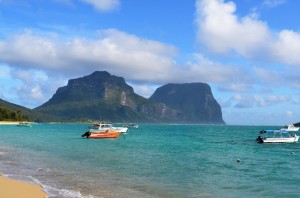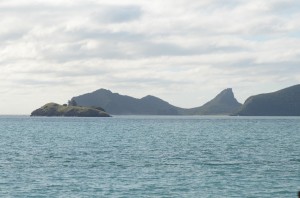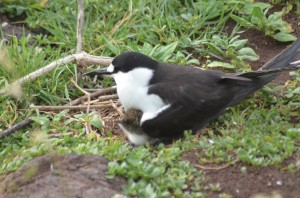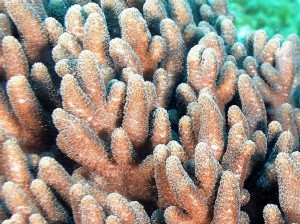Lord Howe Island

It is part of the State of NSW, but is also a marine park and world heritage site. It is an idyllic spot for the family with safe snorkelling from shore in the lagoon, bike rides, walks and mountain climbs and diving.
Lying 450km east of Sydney this island consists of the rocky rim of an extinct volcano with a sheltered lagoon ringed by white sand beaches and Kentia palm groves. While quite hot in summer, the weather is generally mild year round.
The main island of Lord Howe measures 10km long and 2km in width at the widest. It is a crescent, enclosing a coral reef lagoon on its south-western side. The northern tip and south eastern coast have extensive sea cliffs, and there are offshore islands in several locations, the most prominent being Ball’s Pyramid located well to the south of the main island.
The island’s scenery is dominated by Mount Gower (875m) and Mount Lidgbird (777m). These mountains are so gorgeous, that 50% of all the take home postcards include a vista of the mountains. They lie in the rugged south of the island where there are extensive forests and no roads or inhabitants. This area offers challenging bushwalks through banyan tree and palm forests.

Getting there
The island is less than a two hour flight from Sydney (daily) and Brisbane (weekly) via Qantaslink. Numbers of people allowed to visit the islands are limited, so you may have to book 12 months in advance to get there in summer. The short runway means that it can only be used by particular types of smaller aircraft only run by Qantaslink, making it an expensive destination to fly to. The island has a small village with a few accommodation resorts, eateries, convenience stores and dive services. All food, drink, fuel and manufactured goods are imported and everything is a little pricey. As a consequence, most of the visitors are there for a one-off treat, or are relatively wealthy and elderly. The local joke is that you have to be “newly wed, or nearly dead” to go there.
The People
Only a small area of lowland country in the north and central part of the island is fertile, and this is where the island’s population of 300 people live.
There isn’t much of a town to speak of, this is a relaxed, make your own fun kind of place. It’s a great place for a Facebook addict, or workaholic, as they might be forced to go out and talk to the spouse and kids, thanks to the slow satellite communications coverage. You never know, the teenagers might even talk back, when deprived of functioning internet devices.
There is no doubt that the community is unique. It is like “Home and Away” come to life. You can walk around the entire settlement in 40 minutes and are likely to stop and talk with two or three people you have met previously. Houses aren’t locked and locals ‘pop by’ for a chat anytime. Everyone waves to everyone, whether they know you or not. The bush telegraph is active with gossip and you will land onshore and find that people already know the full details of your daily activities. The sighting of a seagull (they aren’t normally seen on the island) was big news while I was there.
The island was settled in the 1840s by a mixture of Europeans, Maori and South Seas Islanders, who basically squatted on the land and were later granted perpetual leases by the government. These original families still hold all the land on the island and sub-lease it to businesses and more recent arrivals. This arrangement is reinforced by an Act of the NSW Parliament which establishes a Board to manage the island. The Board is a bit of a mix between a local council, national park authority, State government committee and independent Parliament. They impose some restrictions that would be seen as anti-democratic anywhere else, including limiting tourist numbers and migration to the island.
Arguably, the restrictions placed on people are necessary as Lord Howe is just too small for the numbers of people looking to live out their dream of getting a chunk of ‘paradise’. Big resorts, blocks of luxury villas, sewerage, pets, litter and roads, are inconsistent with preserving this unique natural environment. All the locals, both original land holders and more recent ‘blow-in’ workers from the mainland are hostile to the kind of glass and steel coastal development that has recently changed the coast of NSW. They don’t want passive big money land development on the island.
It’s all very strange in this era, when we expect uniform living and working arrangements across the entire country. You get the feeling this community, with its restricted business environment, imported goods and expensive public services is a bit artificial. I suspect it couldn’t survive without heavy subsidies from the NSW taxpayer and the local economy is almost solely reliant on tourism. It’s a land frozen in time in many ways, a lot of them good ways.
The Natural Environment

The brochures say it’s a natural paradise, and that is certainly true in many places. But you know what happened to Eden, people inhabited it and then it went downhill from there. The early settlers introduced rats, cats, goats, and pigs, which caused the extinction of several unique bird species. In particular, cats appear to have been a major cause of bird population declines. In the late 1970s, the goats, pigs and cats were removed and the bird population and vegetation has rebounded. The island is now a seabird hotspot, with white terns nesting in trees only a few metres off the ground inside the town. On coastal walks during late spring, seabirds can be seen breeding in the trees, and on rocks and on popular beach dunes. Large mutton bird rookeries exist in any area with soft foreshore soil.
The ocean is a big part of daily life for all the people on the island. When you have toured the town’s shops and caught up on the news, it’s time get out on to a beach, start a coastal bushwalk, or take a boat or kayak out on the lagoon.
The Diving

For the young (or young at heart), scuba diving is a big part of the island’s suite of activities. While we were there, ProDive was the only dive business in active operation. They offer a friendly, engaging, safe and professional service (and no, Aaron is not paying me to say that).
The dive masters are all friendly young ‘blow-ins’ mostly working in the town’s tourist businesses, who help out on days off to relieve the boredom of being trapped in paradise. Even the short-term tourists have picked up on the island’s relaxed social atmosphere and are chatty and engaging. It’s a great social day out, without even talking about the diving.
The island is located at the intersection of five major ocean currents, including the warm East Australian Current. The island’s unique marine ecosystem has very high levels of rare species and huge species diversity. Lord Howe Island is level with Port Macquarie on the Australian mainland, but has coral reefs due to the warm currents. They are the most southerly coral reefs in Australia. You won’t see the massive colourful corals seen on postcards from northern Queensland, but there is plenty of coral variety and big structures, especially in the more sheltered areas.
The fish life is a bewildering mix of colourful tropical species like anemonefish, damsels, angelfish and butterflyfish, living alongside less dramatic temperate species like wrasse. On the deeper and more open sites there is a staggering mix of pelagic fish, trevally, surgeonfish, kingfish, black cod, Japanese boarfish, and spangled emperor. Further inshore the reefs are home to painted morwong, sweetlips, drummer, striped catfish, moray eels, parrotfish, double headed wrasse, lionfish, gobies and hawkfish. The pelagic fish are all large due to the minimal fishing that occurs in this protected area. Sharks are seen on nearly every dive, nearly always the small and harmless Galapagos whaler. A constant on every dive is the Book Fish (Banded Scalyfin), a small and harmless fish that accosts every diver unwittingly encroaching on their ‘turf’.
The invertebrate life is also varied and includes many species of nudibranchs, flatworks, cowries, Spanish dancer, shrimp, hermit crabs, sea stars, featherstars, brittle stars and tube worms. The island mixes the colour and species diversity of the tropics with the rarity and uniqueness of the temperate zone.
There are over 80 dive sites, most located a 10-20 minutes boat ride from shore. Dive depths are from 5 to 30 metres, with an average of 15 to 30 metres visibility. Shallower dives and snorkels can be had in the lagoon. Most tourists go there for summer holidays but the diving season lasts from September to May. Wind averages 13 knots in August, and 9-10 knots in January and March. There are big SW – SE swells from June to October. November to May the wind is less consistent and changes quickly. Sea surface temperatures are from 20 in spring to 24 degrees Celcius in summer.
Prevailing winds are from the south east/south west, meaning that most of the diving occurs on the North and North West around North Passage and the Malabar cliffs and Admiralty Islands. The Admiralties alone have over 30 recognised dive sites. They offer volcanic formations with large pinnacles, coral reef walls and large schools of fish. While the islands are volcanic, many of the offshore reefs are eroded limestone, with lots of structure including caves and gutters. These northern and western sites are close to shelter and are varied enough to cater for dive groups of mixed capabilities that are often the type of travelling diver seeking to use the dive boat. There are also several deeper and more adventurous sites too.
In rough weather the lagoon is also popular, and fortunately has some of the best diving on the island. The shelter offered by the deeper holes in the lagoon turns these sites into refuges for delicate marine life. They are great adventures for the photographer or naturalist.
The remoteness and prevailing wind and swell tend to make the south eastern cliffs less often visited, and they tend to be more barren anyway, except in deeper areas. They do offer some interesting deeper exploratory diving for larger groups of experienced divers, if the weather is good. A trip to Ball’s Pyramid is a highlight, just for the above water scenery as much as the diving. These trips need to be organised well in advance and are very weather dependant.
The climate is humid subtropical with a mean temperature of 16°C in August and 23°C in February. Mean annual rainfall is almost 1700mm, with little falling in summer.
For a one week trip, expect to pay $2500 in air fares and accommodation and about $200 per dive day with gear hire (2016 values). Booking bulk dive packages can reduce prices by as much as 25%.
In summary, it’s a pricey but very unique and worthwhile diving location.
